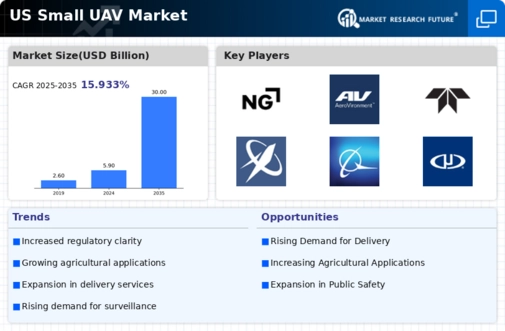Integration of AI and Automation
The integration of artificial intelligence (AI) and automation technologies is transforming the small uav market. AI algorithms enable UAVs to perform complex tasks such as obstacle avoidance, autonomous navigation, and data analysis in real-time. This technological advancement enhances operational efficiency and safety, making small UAVs more appealing to various industries. For instance, AI-driven UAVs can analyze aerial imagery for infrastructure inspections, significantly reducing the time and labor required for such tasks. As AI technology continues to advance, the small uav market is expected to expand, with increased adoption across sectors that require automated solutions.
Advancements in Battery Technology
Battery technology advancements are playing a crucial role in enhancing the capabilities of small UAVs. Improved energy density and efficiency allow for longer flight times and greater payload capacities, which are essential for various applications. The UAV market benefits from innovations such as lithium-sulfur batteries., which can potentially increase flight durations by up to 50%. This enhancement not only improves operational efficiency but also expands the range of applications for small UAVs, from delivery services to surveillance. As battery technology continues to evolve, it is expected that the small uav market will see increased adoption and diversification of use cases.
Growing Interest in Drone Delivery Services
The UAV market is witnessing a growing interest in drone delivery services., particularly in urban areas. Companies are exploring the potential of UAVs to deliver goods quickly and efficiently, reducing delivery times and costs. For example, the market for drone delivery is projected to reach $29 billion by 2030, reflecting a significant opportunity for small UAVs. This trend is driven by the increasing demand for e-commerce and the need for last-mile delivery solutions. As regulatory frameworks evolve to accommodate drone operations, the small uav market is likely to see a surge in investments and innovations aimed at enhancing delivery capabilities.
Increased Demand for Aerial Data Collection
The UAV market is experiencing a surge in demand for aerial data collection across various sectors., including agriculture, construction, and environmental monitoring. This trend is driven by the need for precise and timely data, which small UAVs can provide efficiently. For instance, in agriculture, farmers utilize UAVs for crop monitoring and yield estimation, leading to improved decision-making. The market for agricultural drones alone is projected to reach $4.8 billion by 2025, indicating a robust growth trajectory. As industries increasingly recognize the value of aerial data, the small uav market is likely to expand, catering to diverse applications that require high-resolution imagery and real-time analytics.
Rising Investment in Research and Development
Investment in research and development (R&D) is a key driver of growth in the small uav market. Companies and government agencies are allocating substantial resources to innovate and improve UAV technologies. This focus on R&D is leading to the development of advanced features such as enhanced sensors, improved flight stability, and better communication systems. According to recent estimates, R&D spending in the UAV sector is expected to grow by 15% annually through 2027. This influx of investment not only fosters innovation but also positions the small uav market for sustained growth as new applications and technologies emerge.






















Leave a Comment